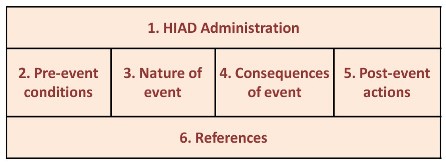
|
BRHS /
Accident Database Failure Rate DatabaseIt is acknowledged in most industries that it is of utmost importance to learn from accidents, incidents and failures of the past to prevent them to happen in the future and to mitigate their consequences. I.e. an important part of the work towards achieving effective risk control one should learn from events, failures and errors committed in the past, and not only within their own industry or company, but also look beyond and draw lessons from elsewhere. The use of incident and failure rate databases as a management tool has shown that it provides an opportunity for an organisation or company to check its performance, learn from its mistakes, and improve its management systems and risk control. Comprehensive knowledge of events having the potential for inducing hazardous situations or loss of production, will also contribute to the corporate learning and memory. On company or plant level, the lessons to be learned from consulting such databases are both qualitative as well as quantitative. They can range from the identification of component/system failures, accident scenarios or initiating events not being predicted in advance to quantitative statistical calculations and estimations to be used in reliability, maintainability or risk studies. They also increase the culture of personnel working in risky technology industries by making them aware of the factors (technical, organisational, human, etc.) and the dynamics that led to accidents or failures. On a national or international level, Safety Authorities are utilising accident databases as an operative and a management tool in several ways, such as following up of the overall safety level within the area of the authority’s interest, resource allocation concentrated and prioritised on the most accident-prone areas and in accident prevention. Accident information taken from a database may also support surveillance visits, in conducting accident investigations and in the work of developing of rules and regulations. Recent progressHydrogen Accident DatabasesHydrogen Incident and Accident Database (HIAD)
Under the EU’s 6th framework programme, a Network of Excellence project “HySafe – Safety of Hydrogen as an Energy Carrier” was established and defined. In this project, a specific Work Package (WP) was devoted to database development, namely the WP5 – Hydrogen Incident and Accident Database (HIAD). HIAD is planned to be one of the tools for communication of risks associated with hydrogen to all partners in the HySafe Consortium and probably beyond at a later stage. In addition, HIAD will serve as a common methodology and format for data collection and storage. HIAD is aiming to hold high quality information of historical accidents and incidents related to hydrogen production, transport (road/rail/pipeline), supply and commercial use. The database will be maintained such that it is updated with the latest information concerning each event for example in order to take advantage of results from accident investigations. Hence, HIAD will, when fully operable be an important source for most tasks constituting a risk analysis process, such as hazard identification, estimation of probabilities and consequences and to propose risk reduction measures. During the work with developing HIAD, the challenge was to develop a tool that should serve various purposes such as being a data source for doing risk assessments and reveal trends and being a source for experience transfer and risk communication. In addition it should be easy to use, so the user friendliness encompassing the tasks of recording and extraction of information/data by having a professional and modern user interface, was hence given high priority. The building blocks of HIAD are illustrated in the figure below.  Fig 2: HIAD building blocks Information held by HIAD and being relevant for risk assessment exercises and related modelling development work could be such as environment/location and application, release size and volume, ignition sources and ignition time (‘ignition modelling’), fire characteristics, description of consequences (input to work with safety distances), damage cost, and causal relations (input to fault tree construction). All information recorded for each event will in general be important for the corporate learning about risks related to hydrogen applications and serve as ballast for the risk analysts in their hazard identification phase of any risk analysis. This work is by experience considered as the most crucial one in the sense that hazards and risk elements not captured here will not be included in the further risk assessment process. It has been decided that HIAD should not be limited to real accidents and incidents, but should also include hazardous situations and near-misses. An example of this is that HIAD should contain all hydrogen releases irrespective of size/volume and not only those that ignited. One benefit of this is enabling the estimation of ignition probabilities from the HIAD data. H2 Incidents
US Department of Energy has published a tool for reporting of hydrogen incidents and a database called H2Incidents at http://www.h2incidents.org/. This database is designed as a simplified version of HIAD, described above. This database has focus on initiating events and pre-event conditions and could be a useful tool for improving check lists and hazard identification tools. The lack of scenario orientation (nature of event) makes it less useful for evaluating likely progress of an initial event. << Risk Assessment Methodologies | Content | Modelling as a Tool for Quantitative Risk Assessment >> |